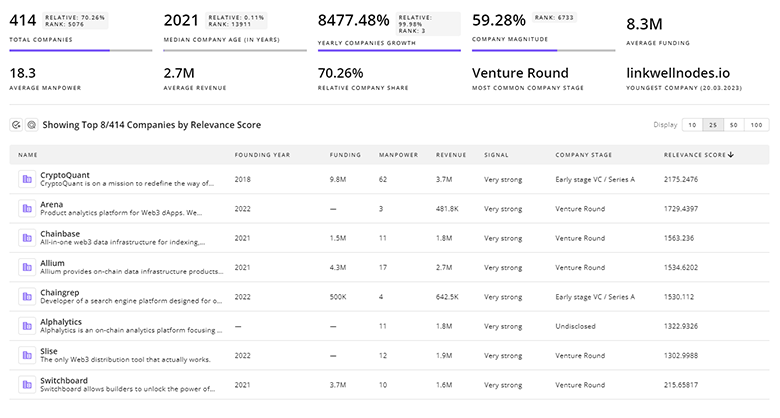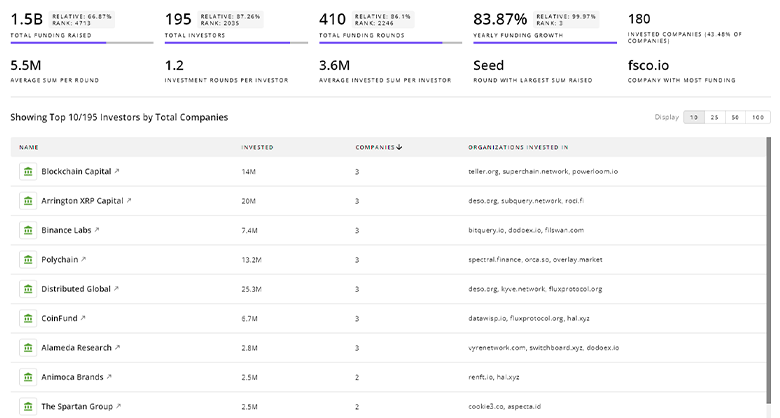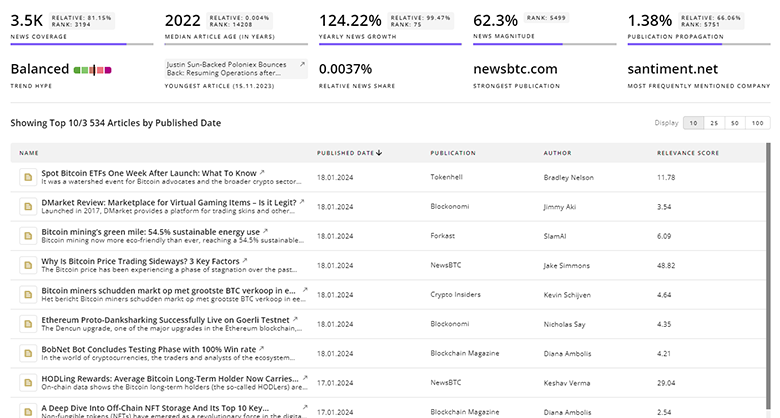
Miniaturized Satellite Report
: Analysis on the Market, Trends, and TechnologiesThe miniaturized satellite sector is experiencing a strategic inflection point, with 1,492 funding rounds raising a total of $32.75 billion according to the internal miniaturized satellite trend report. This capital influx is accelerating the shift from component-level innovation to comprehensive platform offerings. Driven by surging demand for low-cost missions—evidenced by a global market that grew from $3,396.2 million in 2021 to a projected $15,958.6 million by 2031—and a forecasted expansion of the small satellite market to $21,950.8 million by 2035 with a 12.7% CAGR (Small Satellite Market Outlook from 2025 to 2035), miniaturized satellites are set to redefine Earth observation, connectivity, and space services over the next decade.
We last updated this report 42 days ago. Tell us if you find something’s not quite right!
Topic Dominance Index of Miniaturized Satellite
To gauge the impact of Miniaturized Satellite, the Topic Dominance Index integrates time series data from three key sources: published articles, number of newly founded startups in the sector, and global search popularity.
Key Activities and Applications
- Earth Observation and Remote Sensing: AI-powered CubeSats are delivering rapid, high-resolution environmental data, such as the Φsat-2’s on-board image compression for wildfire and pollution monitoring (Miniature satellite Φsat-2 begins science phase for AI Earth images).
- Satellite Communications: Compact terminals like SpaceX’s Starlink Mini are bringing portable broadband to remote areas, enabling out-of-the-backpack connectivity (SpaceX launches Starlink Mini, a smaller satellite internet antenna).
- Positioning, Navigation, and Timing (PNT): Dedicated small-sat clusters are refining satellite-based navigation, exemplified by Iridium’s trials of advanced PNT with small satellites (Iridium exploring small satellites to advance PNT capabilities).
- Space Exploration and Scientific Research: Formation-flying CubeSats are supporting lunar infrastructure and deep-space science, showcased by deployable antenna systems enabling agile inter-satellite links.
- Defense Surveillance and Debris Mitigation: Innovative microsatellites are detecting sub-centimeter debris and autonomously executing collision-avoidance maneuvers to safeguard high-value assets (Designing a satellite to hunt small space debris).
Emergent Trends and Core Insights
- Rising Demand for Cost-Effective Missions: The miniaturized satellite market was valued at $3,396.2 million in 2021 and is growing at a 17.1% CAGR driven by ride-share launches and shorter development cycles (Miniaturized Satellite Market Size & Industry Share|2022–2023).
- Proliferation of CubeSats: CubeSat deployments are expanding as the global CubeSat market jumps from $426.6 million in 2024 to $1,649.3 million by 2033, supporting diverse applications from IoT to PNT (CubeSat Market Size, Share & Trends | Industry Report, 2033).
- Advancements in Electric Propulsion: Scaled-down ion and electrospray thrusters, as small as a silicon chip and capable of deck-of-cards form factors, are enabling extended missions and agile orbit adjustments.
- AI and Edge Computing On-Orbit: Integrating machine learning for real-time anomaly detection and data triage is reducing ground-station bandwidth needs and accelerating mission turn-around.
- Sustainable Constellation Practices: With orbital debris concerns mounting, controlled de-orbit modules and longer mission lifespans are emerging as critical differentiators.
Technologies and Methodologies
- CubeSat Standard: Modular 10×10×10 cm units driving cost-efficient design and rapid development cycles (CubeSat – miniature satellites).
- Advanced Wireless Chips: Miniaturized RF transceivers enhancing beam steering and throughput for small terminals (Transforming Small Satellites with Advanced Wireless Chip for Enhanced Connectivity).
- On-Board AI and Data Compression: Edge computing for image compression and autonomous decision-making, reducing latency and downlink requirements.
- MEMS-Based Thrusters: Micro-Electro-Mechanical Systems enabling coin-sized propulsion units for station-keeping and de-orbit maneuvers (ESA Demos MEMs Rocket Thruster That’s as Small as a Coin).
- Deployable Optical Antennas: Compact lasercom terminals and Fresnel-plate designs delivering high-bandwidth optical links for inter-satellite and ground-station communication (Unfurling Antennas Let Tiny Satellites Do Big Things).
Miniaturized Satellite Funding
A total of 299 Miniaturized Satellite companies have received funding.
Overall, Miniaturized Satellite companies have raised $32.5B.
Companies within the Miniaturized Satellite domain have secured capital from 1.6K funding rounds.
The chart shows the funding trendline of Miniaturized Satellite companies over the last 5 years
Miniaturized Satellite Companies
- IENAI SPACE develops customizable electrospray thrusters and mission-analysis software for CubeSats, enabling extended in-orbit maneuvers and precise de-orbit planning to address space debris risks.
- Spaceflux offers an AI-driven global optical sensor network for space situational awareness, providing real-time tracking and behavioral analytics of orbital objects to governments and insurers.
- Simularity delivers AI-based anomaly detection in satellite and aerial imagery, leveraging historical Sentinel-2 data to prioritize high-value areas for detailed analysis and reduce reliance on costly high-resolution captures.
- Alba Orbital specializes in PocketQube satellites, democratizing access to space with ultra-compact, low-cost spacecraft and standardized form factors for rapid prototyping and educational missions.
- GuardianSat LLC commercializes autonomous collision-avoidance systems and on-orbit defensive measures for small satellites, enhancing spacecraft survivability amid growing congestion and debris threats.
Enhance your understanding of market leadership and innovation patterns in your business domain.

805 Miniaturized Satellite Companies
Discover Miniaturized Satellite Companies, their Funding, Manpower, Revenues, Stages, and much more
Miniaturized Satellite Investors
TrendFeedr’s Investors tool offers comprehensive insights into 1.9K Miniaturized Satellite investors by examining funding patterns and investment trends. This enables you to strategize effectively and identify opportunities in the Miniaturized Satellite sector.

1.9K Miniaturized Satellite Investors
Discover Miniaturized Satellite Investors, Funding Rounds, Invested Amounts, and Funding Growth
Miniaturized Satellite News
TrendFeedr’s News feature provides access to 4.4K Miniaturized Satellite articles. This extensive database covers both historical and recent developments, enabling innovators and leaders to stay informed.

4.4K Miniaturized Satellite News Articles
Discover Latest Miniaturized Satellite Articles, News Magnitude, Publication Propagation, Yearly Growth, and Strongest Publications
Executive Summary
The miniaturized satellite market stands at the crossroads of innovation and consolidation. Significant funding, driven by governments and private investors alike, is accelerating the shift from specialized components to integrated, platform-based service offerings. Companies that master the fusion of AI-driven onboard processing, advanced propulsion, and high-throughput communications will lead in delivering comprehensive solutions for Earth observation, global connectivity, and space sustainability. As orbital congestion intensifies and sovereign data priorities rise, the winners will be those that combine scale, technological integration, and responsible operational practices to meet the evolving demands of both commercial and governmental space users.
We value collaboration with industry professionals to offer even better insights. Interested in contributing? Get in touch!






